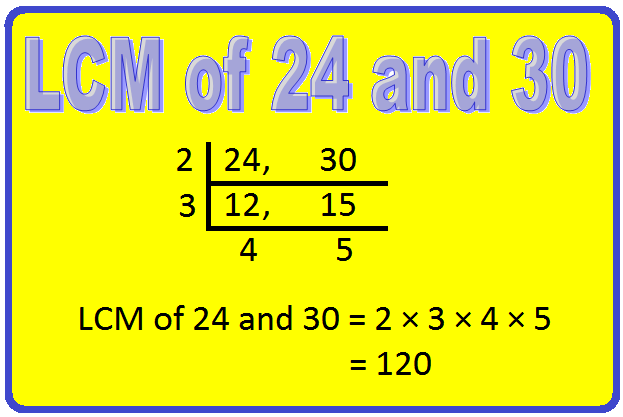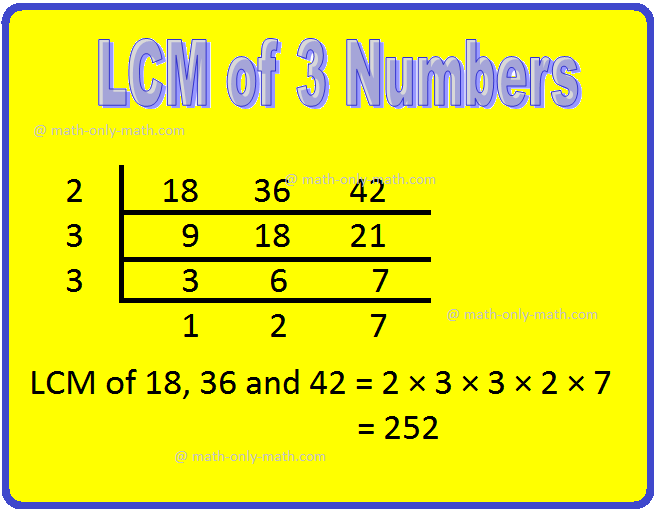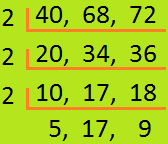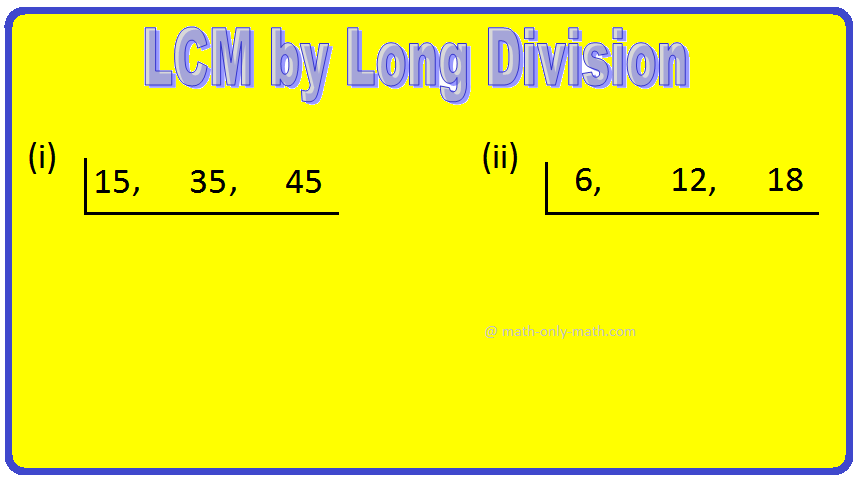Subscribe to our ▶️ YouTube channel 🔴 for the latest videos, updates, and tips.
Method of L.C.M.
We will discuss here about the method of l.c.m. (least common multiple).
1. Let us consider the numbers 8, 12 and 16.
Multiples of 8 are → 8, 16, 24, 32, 40, 48, 56, 64, 72, 80, 88, 96, ......
Multiples of 12 are → 12, 24, 36, 48, 60, 72, 84, 96, 108, 120, 132, ......
Multiples of 16 are → 16, 32, 48, 64, 80, 96, 112, 128, 144, 160, 176, ......
The common multiple of 8, 12, 16 are 78, 96, ......
The least common multiple of 8, 12 and 16 is 48. (Smallest common multiple)
In short, the lowest common factor is expressed as L.C.M.
2. Find the L.C.M. of 3 and 4.
Multiples of 3 = 3, 6, 9, 12, 15, 18, 21, 24, ............
Multiples of 4 = 4, 8, 12, 16, 20, 24, 28, ............
Common multiples of 3 and 4 = 12, 24, ............
Least common multiple of 3 and 4 = 12.
3. Find the L.C.M. of 6 and 12.
Multiples of 6 = 6, 12, 18, 24, 30, 36, 42, 48, ............
Multiples of 12 = 12, 24, 36, 48, 60, 72, 84, ............
Common multiples of 6 and 12 = 12, 24, 36, 48, ............
Least common multiple of 6 and 12 = 12.
Finding L.C.M.
Least Common Multiple (L.C.M.) by Prime Factorisation Method:
To find the L.C.M. we find prime factors of the given numbers.
Remember, we consider common prime factors only.
Solved Examples:
1. Find the L.C.M. of 12, 16 and 24.
First we find the prime factors of the given numbers.

12 = 2 × 2 × 3
16 = 2 × 2 × 2 × 2
24 = 2 × 2 × 2 × 2 × 3
(2 comes maximum 4 times and 3 comes maximum once only.)
L.C.M. = 2 × 2 × 2 × 2 × 3
= 48 which is the product of their prime factors.
2. Find the L.C.M. of 10 and 16.
|
10 = 2 × 5 16 = 2 × 2 × 2 × 2 Common factor = 2 Other factors = 2, 2, 2, 5 |
2 | 10 5 |
2 | 16 2 | 8 2 | 4 2 |
Therefore, L.C.M. = 2 × 2 × 2 × 2 × 5 (common factor × other factors)
= 80
|
3. Find the L.C.M. of 20 and 25. 20 = 2 × 2 × 5 25 = 5 × 5 Common factor = 5 Other factors = 2, 2, 5 |
2 | 20 2 | 10 5 |
5 | 25 5 |
Therefore, L.C.M. = 5 × 2 × 2 × 5 (common factor × other factors)
= 100
4. Find the L.C.M. of 16 and 24.
|
16 = 2 × 2 × 2 × 2 24 = 2 × 2 × 2 × 3 Common factor = 2, 2, 2 Other factors = 2, 3 |
2 | 16 2 | 8 2 | 4 2 |
2 | 24 2 | 12 2 | 6 3 |
Therefore, L.C.M. = 2 × 2 × 2 × 2 × 3 (common factor × other factors)
= 48
Least Common Multiple (L.C.M.) by Division Method:
We can also find the L.C.M. of the given numbers by dividing all the numbers at the same time by a number that divides at least two of the given numbers.
We proceed as below:
Step I: Arrange the given numbers in a line, in any order.
Step II: Divide by a number which exactly divides at least two for the given numbers carry forward the numbers which are not divisible.
Step III: Repeat the process till neither of the two given numbers are divisible by the same number.
Step IV: The product of all the divisors and the numbers left undivided is the required LCM.
For Example:
1. Find the LCM of 24 and 30 by division method.
Solution:
LCM of 24 and 30
=2 × 2 × 2 × 3 × 5 = 120
2. Find the LCM 15, 36, and 42 by long division method.
Solution:
So. LCM of 18, 36 and 42 = 2 × 3 × 3 × 2 × 7 = 252
3. Find the LCM of 12, 16 and 24 by division method.
|
1. When a number is not exactly divisible, we write the number itself below the line. 2. When we cannot divide the numbers by a common factor exactly we discontinue dividing the numbers. |
L.C.M. = 2 × 2 × 2 × 3 × 2 = 48
Note:
The product of L.C.M. and H.C.F. of two numbers is also the product of the numbers.
For example, the L.C.M. of 7 and 14 is 14 and the H.C.F. of 7 and 14 = 7.
We see that the product of 7 and 14 also the product of L.C.M. and H.C.F. of 7 and 14.
4. Find the L.C.M. of 25 and 45.
Therefore, L.C.M. = 5 × 5 × 9
= 225
5. Find the L.C.M. of 40, 68 and 72.
|
Steps: Divide 40, 68 and 72 by 2. 40 ÷ 2 = 20; 68 ÷ 2 = 34; 72 ÷ 2 = 36 Divide 20, 34 and 36 by 2. 20 ÷ 2 = 10; 34 ÷ 2 = 17; 36 ÷ 2 = 18 10, 17 and 18 do not have a common factor. But 10 and 18 have 2 as a common factor. Divide 10 and 18 by 2, leaving 17 as it is. 10 ÷ 2 = 5; 18 ÷ 2 = 9 5, 17 and 9 do not have a common factor. Stop the division. |
Therefore, L.C.M. = 2 × 2 × 2 × 5 × 17 × 9
= 6120
Worksheet on Method of LCM:
I. Find the L.C.M. of the following by prime factorisation method.
(i) 30, 36
(ii) 12, 15
(iii) 5, 7
(iv) 15, 30
(v) 42, 72
(vi) 12, 48
(vii) 60, 75
(viii) 25, 150
(ix) 64, 128
(x) 60, 108
Answer:
I. (i) 180
(ii) 60
(iii) 35
(iv) 30
(v) 504
(vi) 48
(vii) 300
(viii) 150
(ix) 128
(x) 540
II. Find the L.C.M. of the following by division method.
(i) 27, 84
(ii) 16, 32
(iii) 12, 15
(iv) 25, 30
(v) 60, 70
(vi) 30, 18, 60
(vii) 88, 64, 96
(viii) 48, 96, 144
(ix) 26, 28, 24
(x) 16, 12, 20
Answer:
II. (i) 756
(ii) 32
(iii) 60
(iv) 150
(v) 420
(vi) 180
(vii) 2112
(viii) 288
(ix) 2184
(x) 240
III. Find the L.C.M. of the following numbers by listing the multiples.
(i) 24, 36
(ii) 12, 18
(iii) 10, 20, 40
(iv) 27, 108
(v) 63, 84
Answer:
III. (i) 72
(ii) 36
(iii) 40
(iv) 108
(v) 252
IV. Find the L.C.M. of the following numbers:
(i) 6 and 10
(ii) 3 and 6
(iii) 10 and 12
(iv) 4 and 9
(v) 15 and 18
(vi) 6 and 11
(vii) 9 and 18
(viii) 7 and 14
(ix) 8 and 12
(x) 8 and 16
Answer:
IV. (i) 30
(ii) 6
(iii) 60
(iv) 36
(v) 90
(vi) 66
(vii) 18
(viii) 14
(ix) 24
(x) 16
V. Find the LCM by long division method:
(i) 18, 30
(ii) 13, 39
(iii) 12, 15
(iv) 38, 72
(v) 2, 3
(vi) 30, 45
(vii) 112, 140
(viii) 88, 99
Answer:
V. (i) 90
(ii) 39
(iii) 60
(iv) 1368
(v) 6
(vi) 90
(vii) 560
(viii) 792
VI. Find the LCM by long division.
Answer:
VI. (i) 315
(ii) 36
From Method of L.C.M. to HOME PAGE
Didn't find what you were looking for? Or want to know more information about Math Only Math. Use this Google Search to find what you need.








New! Comments
Have your say about what you just read! Leave me a comment in the box below. Ask a Question or Answer a Question.